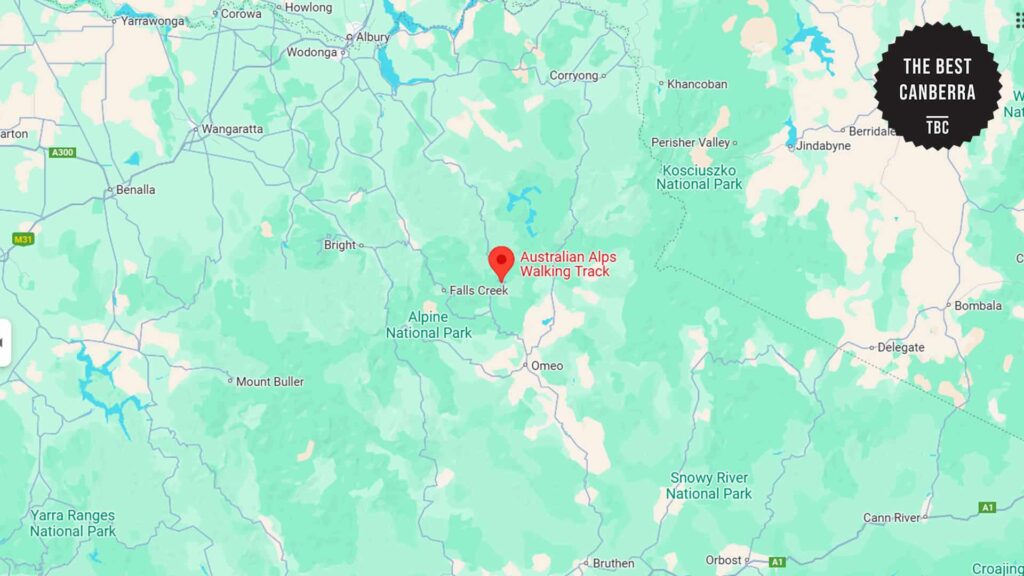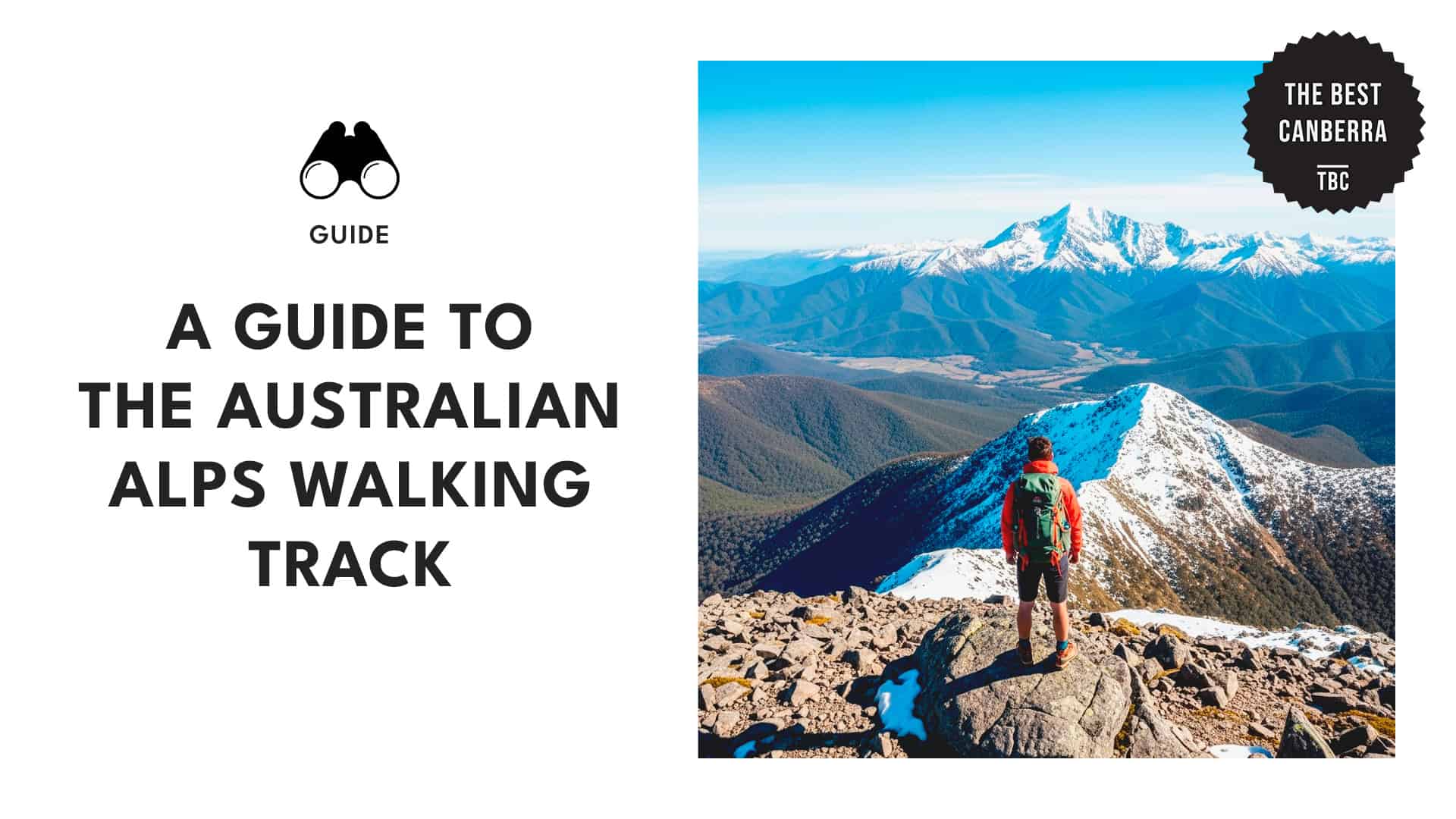A guide to the long-distance adventure at the Australian Alps Walking Track
Did you know that there’s a hiking trail in Australia that takes more than a month to complete? It’s not a loop but a real, challenging track that crosses three states.
The Australian Alps Walking Track, or AAWT, is one of the longest and most challenging hiking routes in Australia. On this trail, you’ll soar up to the snowy mountains and then glide down to the bushy plains.
You’ll be away for a long time, so you definitely need careful planning before setting out. Let us help you with the essentials!
Where is the Australian Alps Walking Track?

The Australian Alps Walking Trail stretches for around 655 kilometers across southeastern Australia. It goes through the high country of Victoria, New South Wales, and the ACT.
How to get to the starting point in Walhalla
Via bus: Walhalla is a small mining town, so there’s no direct bus stop in the area. You’ll have to take the bus routes to the nearest stop, which is in Traralgon. To get there, take bus routes 1, 5, 6, 43, and 44.
To reach Walhalla, you’ll need to take a taxi.
Via taxi or ride-sharing apps: Hire a taxi or book a ride-sharing platform like Uber to take you to Walhalla. Specifically, you can instruct them to drop you off at the rotunda directly opposite the Star Hotel.
This is where you’ll find the path to the first national park, Baw Baw, and begin the track.
Via private car: On your Google Maps or Waze app, type in “Walhalla AAWT trailhead”, and the app will show you the best route to get there. For parking, you can go to the Mount Erica Carpark or the Mt St. Gwinear Carpark.
About the Australian Alps Walking Track
Nature and biodiversity
– Media credit: Michelle – Living Life Wildly Free
The Australian Alps are home to some of the most unique ecosystems in Australia. Because of the increase in elevation, the terrains shift and create microclimates that support a range of rare plant types.
These complex environments directly support the diverse flora and fauna. In layman’s terms, it’s a cycle where the complex environment supports the plants that the animals consume.
For example, the alpine daisies and billy buttons bloom during the summer. These plants support rare animal species like the mountain pygmy-possum because they rely on the bogong moth for food.
Many park websites have detailed field guides and species lists. Take some time to read them because they can help you move more mindfully while hiking through these terrains.
Culture and history
– Media credit: Milou
Long ago, the Australian Alps were a country. The First Nations groups moved through these ranges to gather bogong moths, hold gatherings, and make their own traditions for thousands of years.
It wasn’t long before the European explorers arrived and brought a radical change. Scientists and surveyors, with their scientific and imperial interests, viewed the Alps as uncharted land that needed to be tamed.
So, the summits were measured and the passes were explored. Later on, settlers moved in to start grazing and mining.
Huts and cottages became common, and some of these still stand today and are used by hikers for temporary shelter.
The creation of the Snowy Mountains Hydro-Electric Scheme is considered one of the most transformative moments in the Alps. It diverted rivers and reshaped the water systems to generate power.
While it did help Australia, it has ecological and cultural impacts that are still being assessed today.
If you come across Aboriginal cultural sites, like scar trees or shelters, please observe respectfully and make sure there’s permission before you touch or take photographs.
What to do and see in the Australian Alps Walking Track
Take on the long journey
– Media credit: Hike Australia
A full hike takes between five and eight weeks, depending on your pace and the weather. Here’s a fun fact: the fastest record is just 12 days!
Seasonal timing is very important. The safest and generally the most common period is around November to April, when snow is least likely.
But even so, make sure to regularly check weather updates, as bushfires, heatwaves, and sudden alpine storms can happen.
The ascent to major peaks such as Mount Bogong and Australia’s highest mountain, Mount Kosciuszko, can be scary, especially for first-timers, but you don’t have to rush to get through it!
Always bring a Personal Locator Beacon (PLB). Cell reception is unreliable, especially in remote areas, and a PLB gives you a better chance in emergency situations. There are units that can be rented around the country.
Experience the rough trail
– Media credit: Michelle – Living Life Wildly Free
The walking track is not entirely maintained. It’s mostly stitched together with fire roads, bushes, and singletracks.
Some parts are groomed and well-maintained, while others are just… pure wilderness.
You’re also on your own on some paths because there are no universal signs pointing you south or north, so you have to bring your strong navigation skills into the wild.
The route is divided into three sections: Victoria, New South Wales, and the ACT. The Victoria route is the longest and the toughest of them all in terms of navigation and terrain.
On the other hand, the NSW section gives you snowy mountains, clearer paths, and Australia’s highest peaks. Lastly, the ACT is an area of woodland and open alpine fields.
Remember that the track can be mentally intense with the lack of signage and the challenging terrain. So, make sure that you’re not only physically ready but mentally prepared too.
Don’t forget to look for huts and shelters on the way. It’s one of the necessities, especially if you’re suddenly met with bad weather.
Witness beautiful views
– Media credit: Rachel Presser
One of the best things about this journey is the number of beautiful sights along the way. Each section brings a new ecosystem, so don’t be shocked to see a lush greenland in one place and then a snowy valley in another.
It’s like visiting new countries on foot!
For example, Mount Bogong and Mount Feathertop provide the best 360 summit views that are the prettiest at sunrise.
In NSW, you’ll find snowy mountains, snow plains, and glacial lakes like the Blue Lake.
And finally, further north, the scenery changes again. There are valleys, fern-filled forests, and lots of mountain environments.
It’s also in the ACT where you’ll spot most of the wildlife sightings, such as wild brumbies, eagles, and kangaroos.
Throughout the trails, you’ll also encounter traces of indigenous settlements like old huts, stone fences, and more. Observe respectfully and don’t tamper with these artifacts.
Plan at least one night on a peak or open ridge to catch the beautiful sunset and sunrise. It’ll be the most beautiful view ever.
Try other activities aside from walking
– Media credit: Hike Australia
While the track’s primary purpose is for long-distance hiking, there are other activities that you can have fun with too. So, don’t worry if you’re not into hiking but still want to experience the trail somehow; there’s something for your energy level.
There are driving tours, cycling, camping, horse riding, and more. For alpine lakes and rivers, there’s a growing community of water-based activities such as kayaking, fishing, and swimming.
Most parks offer driving tours to lookouts and picnic areas accessible by 2WD or 4WD. However, in winter and early spring, many roads in the Alps are closed or require snow chains.
For bush camping, it’s mostly free in national parks but has group size restrictions and designated areas. Always plan with precision, and check park maps, local alerts, and seasonal closures for your selected activity.
See multiple national parks
– Media credit: Emmie Li
There are 12 national parks and reserves in the Australian Alps across state and territory borders.
Together, these parks form the Australian Alps National Parks Committee, a cross-border agreement that recognizes these parks as one ecological and cultural unit.
The bodies from all three jurisdictions monitor vegetation, manage invasive species, and generally maintain the places. The least we can do for these parks as we pass by is to tread lightly, don’t litter, and don’t commit disturbing acts against the ecosystems.
Each of these parks has rules and regulations. Take some time to research and follow these rules accordingly to maintain order.
Where to stay near the Australian Alps Walking Track
Victoria: Mount Baw Baw Alpine Resort
– Media credit: Mt. Baw Baw
Website: https://www.mountbawbaw.com.au/accommodation/
Address: Currawong Rd, Baw Baw Village VIC 3833, Australia
Phone: +61351651136
Operating hours: 24 hours
If you’re about to tackle the walking track and want to store energy before setting out, this place is worth checking out. You’ll be situated in a place with a cool alpine breeze, stunning mountain views, and close proximity to the starting point of the AAWT.
For options, you can choose from family lodges, self-contained cabins, and simple dorms. Most of these units include kitchens and heating.
Staying here is a big advantage because of the proximity, and the staff are familiar with the conditions and they can give you advice about the weather and safety.
They also have a store if you want to stock up on gas, food, and supplies before your long journey.
New South Wales: Valhalla Perisher
– Media credit: Valhalla Perisher
Website: http://www.valhallaperisher.com/
Address: 31 Candle Heath Rd, Perisher Valley NSW 2624, Australia
Phone: +61295234885
If you’re in the central portion of the track, there’s also accommodation waiting for you. The Valhalla Lodge is a cozy place with cool mountain air and beautiful scenery.
The place has private rooms and communal spaces as well. Breakfasts and dinners are also included in most packages.
The place is perfect if you want to refuel. After all, not all of us can handle the physical demands of this strenuous hike in one go; some hikers need to recover in between.
ACT: Wildfest at Tidbinbilla
– Media credit: Experience Nature
Website: https://experiencenature.au/
Phone: +61 418 262 282
Operating hours: 9:00 am – 5:00 pm
If you want to comfortably wrap up your successful hike, Wildfest at Tidbinbilla will give you a glamping experience in the wilderness.
It’s a little off-grid, but the facilities are high-end with queen beds, eco-bathroom amenities, and even a private deck where you can enjoy the beautiful view of the mountains in the morning.
However, Wildfest only operates occasionally, so if you’re interested, regularly check their website for schedules and bookings.
What to keep in mind when visiting the Australian Alps Walking Track
Entry and exit points
– Media credit: Zorali
The walking track is convenient and accessible because there are multiple entry and exit points. While the trail is designated for an end-to-end hike, it’s also popular to hike in sections.
So, if spending eight weeks hiking on the trail sounds impossible, you can cut corners with this one!
If you want a high-alpine experience right off the bat, Mount Hotham is a strong option. There’s also the Bogong High Plains if you want something physically moderate.
For NSW, Thredbo and Kiandra are the most popular start and end points.
In the ACT, there’s the Northern Terminus, however, this point is typically used as an early finish line or a starting point to walk or hike in reverse.
If you’re planning a section hike, prioritize your transportation. Many entry points are in remote regions with no public transportation.
You can arrange a vehicle drop, hire a local shuttle service, or join hiking forums where hikers often arrange group pick-ups and drop-offs.
Fragile ecosystem
– Media credit: Laura Waddell
The Alps’ ecosystem is fragile and should be treated with more than admiration. These minimal actions can greatly help the track as it’s already under pressure from tourism, climate change, and fires.
Consider it like you’re walking into someone else’s home.
The first rule is “Leave No Trace.” Don’t step on the moss beds, don’t scar the trees, and don’t tamper with the signage – just leave the place as is.
Here’s another one: “Carry it in, carry it out.” Don’t bury your rubbish, even the biodegradable ones.
Decomposition is slow in high areas, so it can attract animals that don’t belong there.
And more importantly, it’s better to use a fuel stove than a campfire. The Alps are already prone to fires, and while there are areas that permit campfires, it can still increase bushfire risks.
Start practicing at home. It might feel awkward at first, but it’s important to get used to these habits. These are simple ways to help maintain the tracks.
Safety precautions
– Media credit: Rachel Presser
The remoteness, height, and unpredictable weather can easily turn your adventure around. Every year, there are reports of incidents from minor injuries to horrifying accidents.
So, even if it seems like a peaceful and casual hike, keep in mind the saying, “Prevention is better than cure.”
Always check the weather forecasts before heading out and carry gear for wet, cold, and windy conditions. Hypothermia is a real risk regardless of the season, especially at heights above 1,500 m.
While streams and snowmelt may seem clean, don’t skip the step of treating them by boiling or using purification tablets.
Snakes are active in warmer months, so make sure to wear gaiters and avoid long grass. Some of them love to camouflage, so step carefully!
It’s a rookie mistake to assume that huts have stocks of food. Most are just emergency shelters, so make sure you bring lots of food too!
Permits and restrictions
– Media credit: Ethan Le Duc
In general, hiking and walking don’t require permits, but camping and starting a fire do. There are designated zones for camping, campfires, and fuel stoves.
For camping, some areas like the Baw Baw National Park implement group size limits. There are also areas where rangers enforce maximum stay durations.
In the ACT, most areas ban campfires all year round, and group sizes are limited. Dogs and drones are also prohibited in most of the AAWT because they can disturb the wildlife.
Also, it’s common to see some parks closed or with restricted access due to bushfire damage or extreme weather. So, before setting out, always check the current conditions of the sections.
Many huts are heritage-listed, so avoid lighting fires inside or hanging your gear from the rafters.


